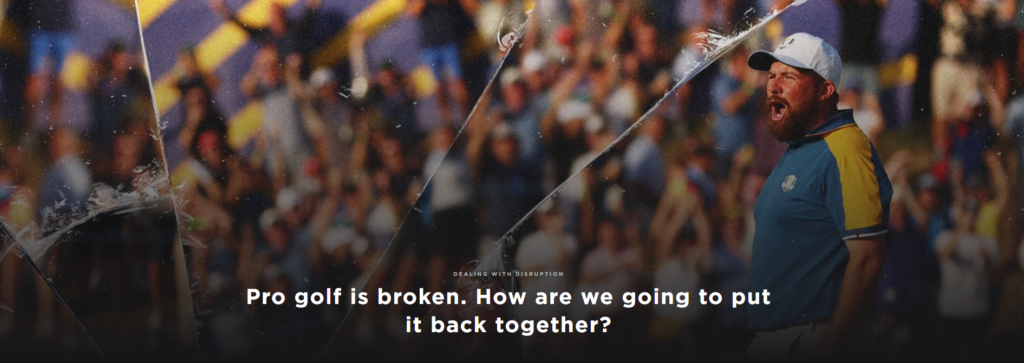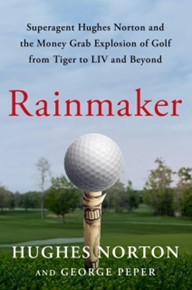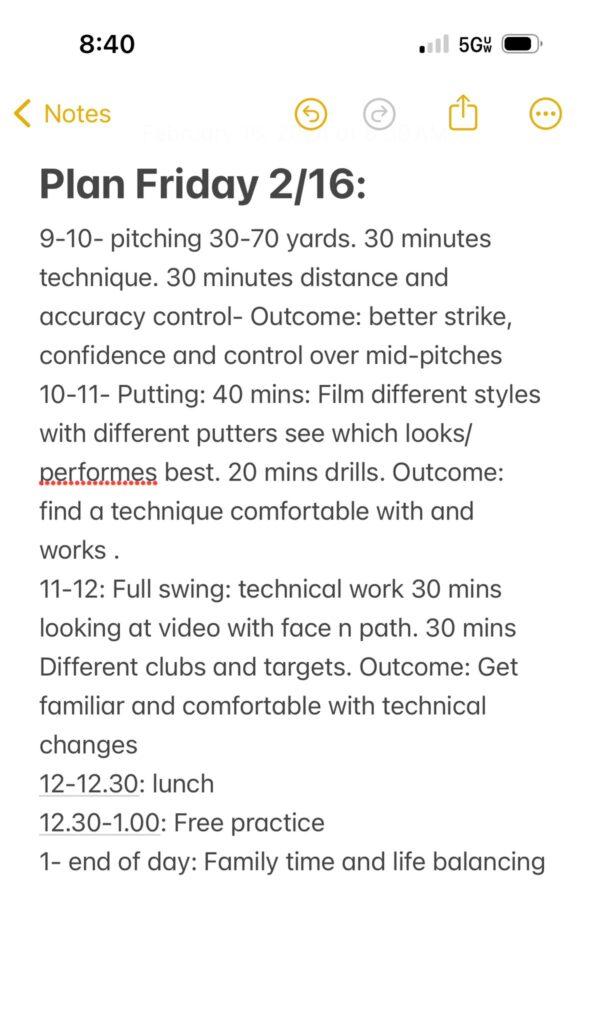How Are We Going to Put it Back Together?

Jerry Tarde, Golf Digest
The first book I remember my father reading was Situation Golf by Arnold Palmer. The first golf tournament I remember watching was the 1972 U.S. Open at Pebble Beach won by Jack Nicklaus. In the way only sporting heroes speak to you, I’ve been rooting for pro golf my whole life, so take this as a lover’s lament, not the grieving of a cynic: Pro golf is broken, and I’m worried about how it can be put back together.
We shouldn’t be surprised by the inquiry because it follows a familiar pattern. Bret Stephens in The New York Times wrote that “brokenness has become the defining feature of much of American life: broken families, broken public schools, broken small towns and inner cities, broken universities, broken health care, broken media, broken churches, broken borders, broken government.” Why shouldn’t pro golf be broken?
We thought the PGA Tour was invincible until it wasn’t. We watched every other industry undergo disruption while pro golf only upticked continuously. Tournament prize money increased year after year despite recessions, wars, scandals, pandemics and all forms of economic turbulence.
Ever since World War II, pro golf built its foundation on five principles: (1) The top players like Arnie and Jack always put the game above themselves. (2) Golfers are accountable to their performance—nothing’s guaranteed. (3) The pro tours are kept in check and balance by the four independent governing bodies controlling the major championships and acting in the best interests of the game. (4) Pro golf is underpinned by charity; that’s why hundreds of volunteers show up every week to help run the tournaments. (5) The game’s leaders—not always, but generally—have used the time-honored Masters strategy of leaving money on the table in exchange for control and sustainability.
It began to break down when suspect morals and unlimited resources tested the first two principles. Some top players saw themselves as victims of income disparity and thought they were not only entitled to the growing prize money, but it wasn’t enough. Defections and betrayal followed.
The PGA Tour and the LIV Golf League fell into what historians have called Thucydides Trap. “It was the rise of Athens and the fear it instilled in Sparta that made war inevitable,” wrote the Ancient Greek general Thucydides. When a newcomer threatens authority, war is only averted with deft statecraft. Curiously given the short-game touch of its stars, the PGA Tour doesn’t do deft.
That’s how we got to where we are. Our immutable conscience will always cause us to struggle with the resolution of pro golf’s circumstance, but as Tiger Woods taught us, “It is what it is.” Power and money will be consolidated. Private equity and the Saudis will bring change and a new world order. The question remains, can all this brokenness get fixed?
It’s undeniable that we have a messy, uneconomical system. Two organizations based in New Jersey and Scotland make the rules; neither is a pro tour. Maybe the most influential governing body is a private golf club in Georgia. If pro golf were starting over, we would have one governance structure, one back office and the best golfers playing against each other more often. But I don’t think the PGA Tour’s new money realizes you can’t get from here to there.
When a newcomer threatens authority, war is only averted with deft statecraft. Curiously given the short-game touch of its stars, the PGA Tour doesn’t do deft.
If PGA Tour Enterprises is a for-profit venture, will the players and the investors continue to care about charity and the communities that have always supported pro golf? It’s telling that none of the investors are members of Augusta National, meaning part of the golf establishment. The bet is that they’re smarter than everybody who has run pro golf all these years, and that will be painful to see play out.
I was walking a tour course the other day when a billboard flashed the advertisement that “Konica Minolta is the official multifunction printer of the PGA Tour.” They’ve sold not only the silverware, but the spoons separate from the knives and forks. I said this to an insider, and he replied, “Hell, we’ve even sold the butter knives.” It’s hard to imagine two things: that the players aren’t already making enough money and that there’s a lot more money still to be extracted from media and sponsors.
Market forces determine what something’s worth, but an outside influence like the Saudi Public Investment Fund seems to have artificially inflated tour pros’ value, and they now think they’re worth that much. Maybe they are and maybe they aren’t, but we’ll see a reckoning in a couple of years.
There are two schools of thought: Some pros think they’re being exploited by the major championships, which return only 10 to 20 percent of revenue to the pros. The reality is that the majors probably could afford to pay back $30 million in purses (rather than the current $20 million) but nowhere near the 50-percent return the pros or new investors think they deserve. The other school of thought was expressed by a young major champion who said privately: “You gotta be kidding! I’d pay to play in a major; they don’t have to pay me. Win one and it’s life changing—you’ve made your career.” I’d hate to see the U.S. Open or Open Championship go the way of the AIG Women’s Open with title sponsors, but it may be necessary for the governing bodies to continue to service the world game with handicapping, agronomy and amateur competition.
The PGA of America faces a different challenge. With the DP (European) Tour and the PGA Tour under one roof, the players might implicitly boycott the Ryder Cup unless the PGA of America turns over control. Commissioner Jay Monahan’s a nice guy, but he has a fiduciary responsibility to call PGA of America CEO Seth Waugh and say, “Sorry, pal, but you’re going to sell us the Ryder Cup, and here’s what we’re going to pay.” Flush with private-equity cash, would it be a surprise if the PGA Tour also bought the PGA Championship? Maybe the club pros still get to wear their red plaid jackets and march in the TV parade, but have we seen the last of these majors played under PGA of America ownership?
What else will the PGA Tour buy? Besides giving $1 billion in equity to the players who remained loyal to the tour, they’ll probably start buying up the rights to tournaments. Only a handful of the current 40-plus PGA Tour events are owned by the PGA Tour, and none of the majors. If the tour owns the event and the arenas, there may be more profit. Gambling is uncharted territory, but investors believe owning golf betting will pay off. Media rights fees are another matter. Pay TV is under stress as revenue has declined seven percent annually with the shift from cable to streaming. Live sports may be the lifeblood of media, but the deep dark secret is: Pro golf’s a minor sport that doesn’t draw the audiences or drive the subscriptions of the NFL, NBA, college football, the Olympics or Premier League. Will big new media still value little old golf? (Full disclosure: Golf Digest’s owner, Warner Bros. Discovery, might be one of those bidders.)
All the question marks are about pro golf, not the game we play. If the brokenness gets fixed, it’ll be because recreational golf is incredibly healthy.
But all the question marks are about pro golf, not the game we play. If the brokenness gets fixed, it’ll be because the PGA Tour is only the tip of the iceberg. Recreational golf is the 99 percent below the surface, and it’s incredibly healthy. All the leading indicators of participation are showing sustainable growth. It’s more diverse; the business is stronger; golf-course construction has started to reverse its decades of decline, and new variations on the old game are attracting kids and women at record levels. What COVID started, remote work and a strengthening U.S. economy ensures. Just look at the latest study released by the National Golf Foundation:
• Rounds played are up 20 percent since the start of the pandemic (2019), an all-time record at 531 million.
• More than 90 percent of golfers expect to play as much or more in 2024.
• “Green-grass” participation hit 26.6 million last year—the biggest single-year jump since the Tiger Slam (2001).
• On-course participation growth since Covid shows increases in play by youth (up 40 percent), people of color (up 27 percent) and women (up 25 percent).
• Sixty percent of the growth since 2019 has been female participation.
• Latent demand among non-golfers’ interest in taking up the game has hit a record 22.4 million.
• Alternative forms of the game like Topgolf are up 130 percent, driving a record number of total golfers to 45 million, and people with this off-course experience are five to six times more interested in playing on-course golf, portending even better news for the game’s future.
• Here’s the one I like best: Stanford University analysis of vehicle and phone GPS data suggests the increase in rounds played has been powered by Monday-Thursday play. Don’t tell your boss, but early-week tee times are fueling the boom.
The view here then is that the amateurs will help bail out the pros. The new tour can expect years of disruption, but the five original principles that guided the professional game since WWII will prevail. I think it was Churchill who said, “You can always count on golfers to do the right thing, after they’ve tried everything else.”
*****
Here is the best line from this great piece by Jerry Tarde:
It began to break down when suspect morals and unlimited resources tested the first two principles. Some top players saw themselves as victims of income disparity and thought they were not only entitled to the growing prize money, but it wasn’t enough. Defections and betrayal followed.
Here’s my shortened version:
“What’s best for the game” was replaced by “What’s best for me.”
Selfishness and greed, a central feature of the human condition, had won again.
The Head Nut
#0001













